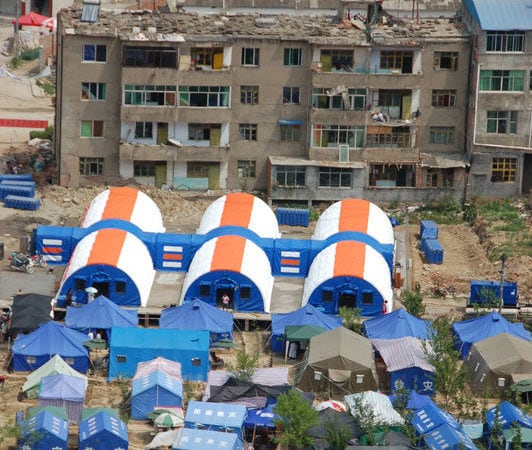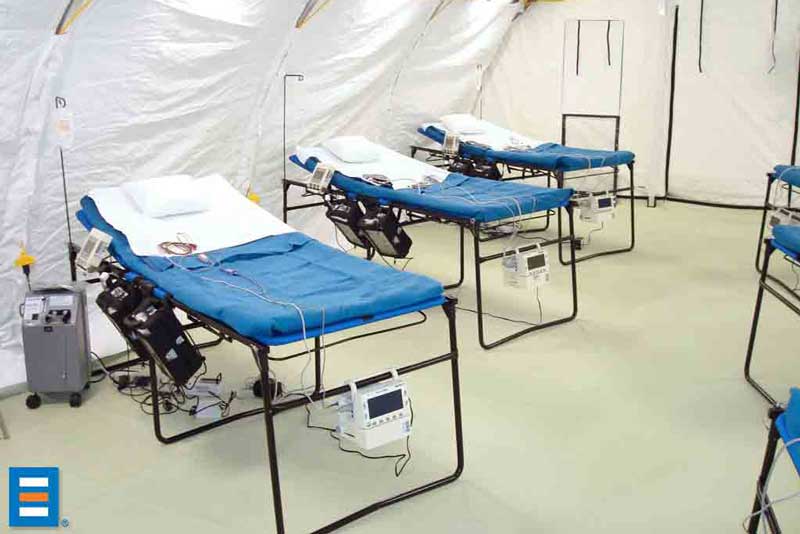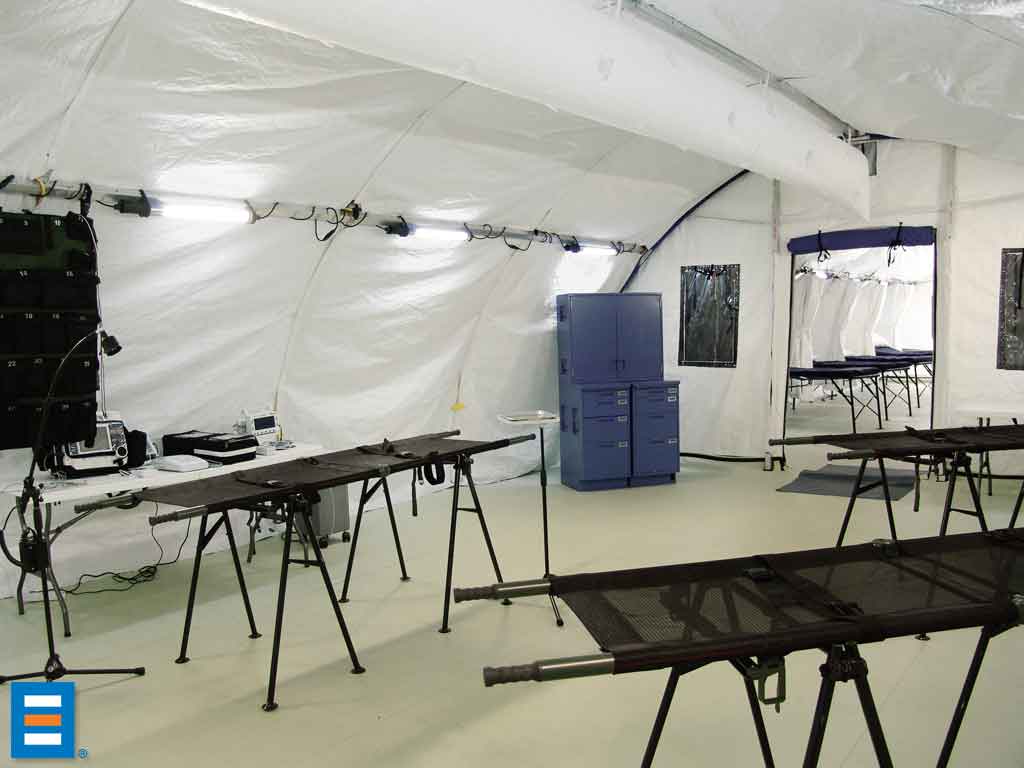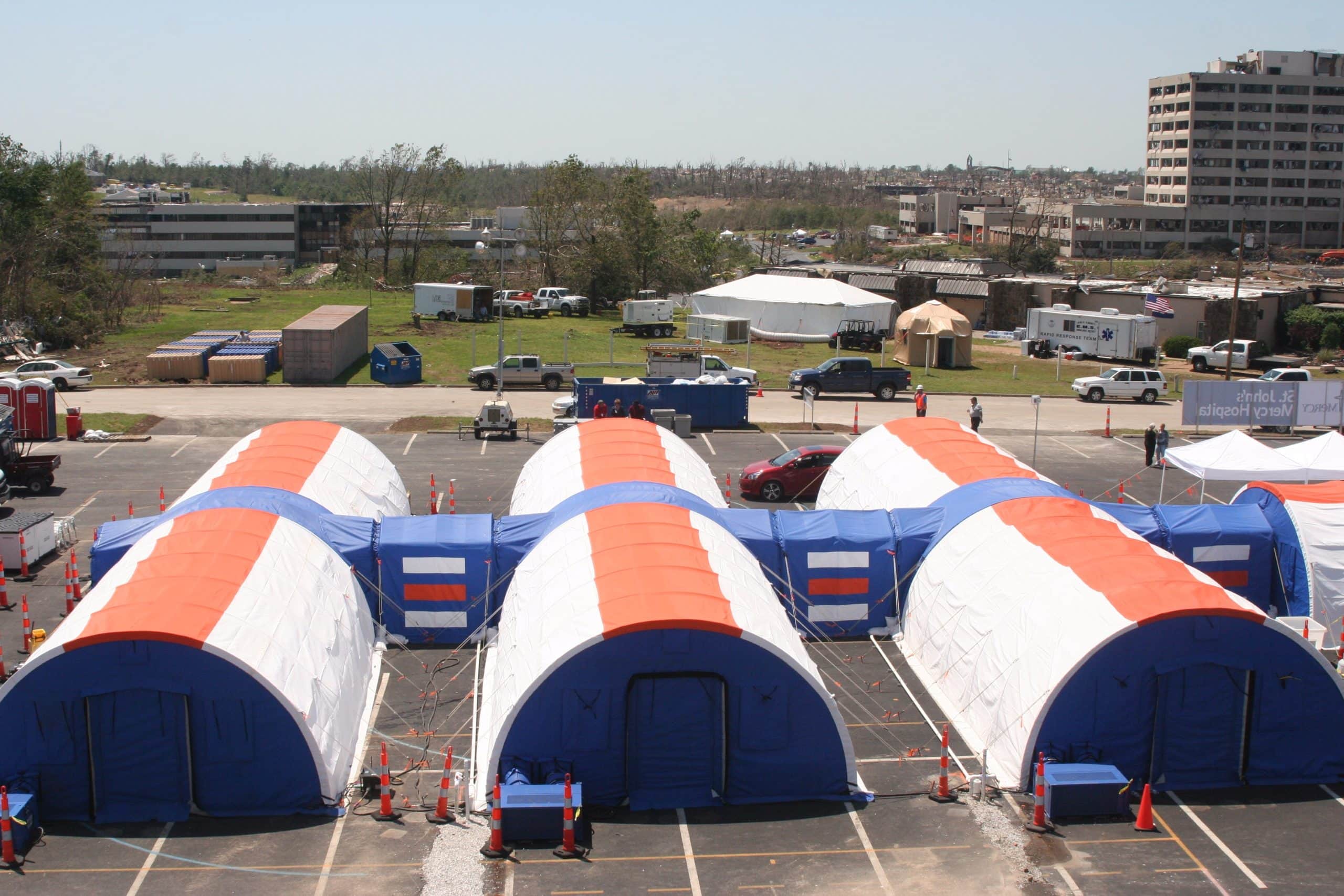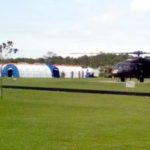Field Hospitals
Combat and disaster zones require complete medical support for everything from simple illnesses and scrapes, to intensive care, surgery, and even isolation capacity in the event of the outbreak of a disease or virus such as Ebola.
Portable field hospitals provide the rapid deployment and setup, ease of transport, and comprehensive medical services and equipment to serve as ward facilities for patient recovery as well as sterilized environments for sensitive procedures.
Defining Field Hospitals
The major difference between a traditional hospital establishment and a field hospital is that the latter is a more temporary and portable facility, which is usually established near a battlefield or disaster area to support troops or disaster victims.
A comprehensive field hospital typically includes a mobile medical unit to meet the needs for immediate patient care, getting the patient(s) into stable condition in order to transport them to permanent hospital facilities. The field hospital is additionally equipped with a trained and skilled medical staff and all necessary equipment and supplies contained in a portable, yet durable fabric structure.
Field hospitals are constructed from lightweight, yet durable materials such as high-strength polyvinyl chloride (PVC) fabric and a powder-coated aluminum frame. They can be rapidly set up and taken down, making these mobile field hospitals the most efficiently portable medical facility option available. The most premium fabric structures for medical applications can be deployed and fully operational within just 72 hours.
Modern Applications for Field Hospitals
The U.S. Air Force Expeditionary Medical Support and U.S. Army Combat Support Hospital programs both use BLU-MED Response Systems® mobile medical systems around the world for military and civilian applications.
In addition to providing critical care for wounded soldiers in combat zones, modern field hospitals are ideal for mobile treatment of civilians in the event of terrorist attacks, virus outbreaks, and natural disasters.
Today, field hospitals are used for a variety of applications, depending on the level of need for medical treatment and care.
Some common uses for field hospitals and mobile medical treatment facilities include:
- Disaster Response
- First Aid Shelters
- Triage
- Surgical Centers
- Treatment/ICU
- Ward Beds & Convalescence
- Hospital Surge/Expansion
- Negative Pressure Isolation
- Ebola Treatment
- Pre-Evacuation Stabilization
- Postoperative Care
- Pharmacy
- Mobile Morgue
Field Hospitals Through History
Mobile hospitals have been a crucial part of every war in history. From ancient battles and sieges, to the combat support hospitals that followed troops throughout Europe during World War II, mobile field hospitals and evacuation hospitals have saved countless lives.
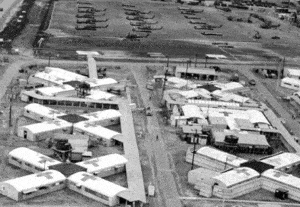 In the days before antibiotics, they were the site of agony and death for most patients as overwhelmed and under-equipped physicians did the best they could to make the wounded as comfortable as possible in their final hours. In the past 100 years however, radical discoveries, improvements and innovations in medicine, such as the 1929 discovery of penicillin, have transformed field hospitals into life-saving, effective treatment facilities. Developments in the design and functionality of these facilities have also made them more portable, equipped for a wider range of uses, and safer for sensitive treatment procedures.
In the days before antibiotics, they were the site of agony and death for most patients as overwhelmed and under-equipped physicians did the best they could to make the wounded as comfortable as possible in their final hours. In the past 100 years however, radical discoveries, improvements and innovations in medicine, such as the 1929 discovery of penicillin, have transformed field hospitals into life-saving, effective treatment facilities. Developments in the design and functionality of these facilities have also made them more portable, equipped for a wider range of uses, and safer for sensitive treatment procedures.
Throughout the Civil War, the public perception of medical facilities and staff was quite negative, perpetuated by disorganization and inadequacies on both sides. Field hospitals were horrific, bloody places where most severely wounded soldiers expected only to find some small comfort as they died. The ignorance of bacteria resulted in rampant infections — even after successful life-saving procedures. Despite these issues, however, both the Union and Confederate medical departments were able to improve the standard of care provided to sick and wounded soldiers rather quickly, and the Union even developed hospital trains to quickly and safely transport wounded and sick to more established hospitals for treatment.
During World War II, field hospitals typically had 400 beds, while evacuation hospitals had a capacity for 400 or 750 beds. Historically, they “arrived within a few days of an invasion and followed the army, staying about thirty miles behind the front. They were close enough to treat patients quickly and send them back to the front quickly as well. These hospitals relied on mobility.” Field hospitals were kept closer to the front and evacuation hospitals were closer to the rear in the European Theater, while they were used interchangeably in the Mediterranean Theater. In both regions, ‘leapfrogging’ (Hospital A would pass Hospital B, and then vice versa) allowed the front to advance with minimal frequency of hospital moves.
Beyond the simple mobile field hospitals that had been in use for centuries, portable surgical hospitals designed for more sensitive medical care were developed midway into World War II. These units were adopted by the U.S. Army in 1943. It was a compromise solution to meet a critical need, and as such, these units had several key shortcomings.
Today’s mobile field hospitals for surgery and sensitive medical treatment have radically improved over the 1943 version, resolving the early hospitals’ key weaknesses:
- While the original hospitals lacked the equipment needed for definitive surgery in order to maintain their portability; modern units are manufactured with lightweight materials and equipment.
- The earliest portable surgical hospitals had insufficient bed capacity for postoperative patients; today’s structures can be expanded with additional systems for more capacity.
- The old version was never entirely self-sufficient; most manufacturers of today’s mobile field hospitals offer add-on systems for power generation and distribution, electricity and lighting, environmental control and more for fully standalone hospitals.
In light of modern developments in medicine, medical technologies, and even building innovations, today’s mobile field hospitals are ideally suited for a wide range of needs for the preservation of human life. Their advantages over traditional hospitals, including portability, longevity, versatility, customization, and standalone capacity, make these units highly necessary for effective disaster response and combat support.
BLU-MED Response Systems® (BLU-MED) was formed in 2004 as a division of Alaska Defense™ – the military division of AKS Industries, Inc.
Alaska Structures (AKS) is an industry leader in designing camp; engineering fabric building systems for extreme climates. Our shelters have undergone extensive tests and have been deployed in over 85 countries with more than 28,000 Alaska Military Shelters being installed worldwide.
For more information about BLU-MED or Alaska Structures call a representative at +1-888-680-7181 or 425-739-2795.
